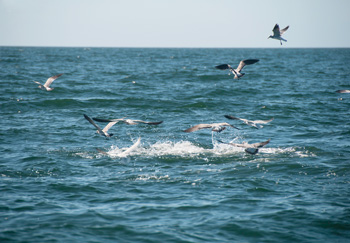The secret to finding fish

Rusty chinnis | submitted
Diving birds and striking fish lead anglers to action
off the Anna Maria beaches.
Finding fish is the goal of every fisherman and the best strategy I’ve encountered after years on the water is to stay aware and be flexible. While there are many “tried and true” methods to finding fish, there is no magic formula. I’ve used Captain Scott Moore’s explanation before, and while it’s simple, there’s a lot of truth to it.
When I asked him his secret to finding fish, his answer was, “Fish move around.” Moore was referring to the fact that fish move from one area to another according to a number of factors that we’ll never completely understand. Successful fishermen are flexible, keep an open mind and are always alert for clues.
The best strategy is to start with a plan, but stay open to conditions that might alter your original plan. There are some basics to understand, including the fact that fish are likely to congregate in areas where there’s food, safety, and comfortable conditions.
Fish also will be affected by weather, particularly the barometer, tide stage and current. And while it may be true that the more factors that apply at any given time, the better the chance that you’ll find fish nearby, there’s no guarantee. That’s why it’s important to always be vigilant and flexible.
When fishing local bays, some of the key things to look for are current, feeding activity and structure. Current concentrates a fish’s food source, acting like a natural conveyor belt bringing prey to a waiting predator
For example, snook will take up position just outside the effects of the water flow in an area that acts as an ambush point. Drifting live bait or working lures and flies in those areas is a good strategy. Feeding activity can be as obvious as breaking fish and diving birds or as subtle as wading birds on a grass flat at low tide.
Local grass flats provide structure and are home to a plethora of the game fishes’ food sources. The slues and potholes that contour the grass flats can also function as current funnels. Oyster beds are natural structures that attract fish as are dead trees in the water in local bays and passes. Man-made structures including seawalls, jetties and dock pilings also provide many of the conditions that will attract game fish.
When fishing the Gulf, birds feeding on the surface can lead you to actively feeding fish or pods of bait that attract predators. Baitfish can also be stationed over structure that attracts both baitfish and game fish. Prime structure in the Gulf includes natural hard bottom and ledges, artificial reefs and wrecks.
Each situation can be different. At times you’ll find bait over structure that leads to great action, while at other times it’s possible to find fish near structure when nothing is showing on the surface. The opposite is also true, and at times you might find structure with actively feeding birds and surface action, but no fish.
The shoreline along the Gulf can also be an excellent place to locate fish. I’ve often found it amusing that some anglers wade out as far as possible when the majority of the fish are actually behind them right in the surf line. The shore acts as a natural line that fish follow and also holds food sources including crabs, bait fish and other invertebrates that also feed in the surf.
Most anglers don’t have the luxury of picking and choosing the optimal conditions when they go fishing and must just follow the old adage that the best time to fish is whenever you can. That’s not bad advice because at times, despite the conditions, fish will still be active. The important point is to know the basics, but be aware and flexible enough to take advantage of the pleasant surprises that can often come your way when you find fish in unexpected places. After all, fish move around.

